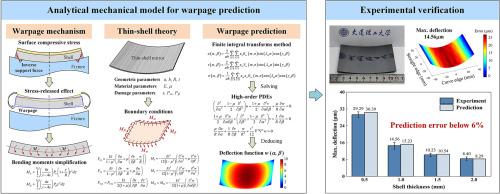开口圆柱薄壳镜磨削翘曲的解析力学模型
IF 9.4
1区 工程技术
Q1 ENGINEERING, MECHANICAL
International Journal of Mechanical Sciences
Pub Date : 2025-09-27
DOI:10.1016/j.ijmecsci.2025.110894
引用次数: 0
摘要
薄壳硅反射镜是轻型x射线光学系统的关键部件。然而,磨削会引起表面压应力和亚表面损伤层,从而导致这些开放圆柱形薄壳结构的翘曲变形。薄壳的曲率效应导致了一种独特的翘曲机制,这一机制尚未被探索。本研究开发了一种新的分析力学模型来预测翘曲行为,确定夹具移除过程中的应力释放效应是主要驱动因素。利用Donnell-Mushtari壳理论,推导了控制自由边界上弯矩作用下挠曲变形的高阶偏微分方程。应用二重有限傅里叶积分变换求解这些偏微分方程,得到精确解析解。该模型将翘曲直接与壳体几何形状、材料属性和损伤参数联系起来。对不同厚度硅薄壳的超精密磨削实验验证了该模型的正确性,结果表明,预测偏差与测量偏差小于6%。值得注意的是,增加壳体厚度可以降低翘曲敏感性。磨削参数,如细粒度树脂结合砂轮、更高的砂轮速度、更低的进给速率和更小的磨削深度,可以促进塑性去除,产生更浅的亚表面损伤层,并有助于减少翘曲。这一理论创新为翘曲预测提供了一种有效的计算方法,从而促进了薄壳结构的高精度制造。本文章由计算机程序翻译,如有差异,请以英文原文为准。

Analytical mechanical model of grinding-induced warpage in open cylindrical thin-shell mirrors
Thin-shell silicon mirrors are critical components in lightweight X-ray optical systems. However, grinding induces surface compressive stresses and subsurface damage layers that can lead to warpage deformation in these open cylindrical thin-shell structures. The curvature effect of thin-shells results in a unique warping mechanism that has remained unexplored. This study developed a novel analytical mechanical model to predict the warpage behavior, identifying the stress-released effect during the fixture removal as the primary driver. Using Donnell–Mushtari shell theory, the study derived the high-order partial differential equations (PDEs) for governing warpage deflection under bending moments acting on the free boundary. A double finite Fourier integral transform was applied to solve these PDEs and derive exact analytical solutions. The model links warpage directly to shell geometry, material properties, and damage parameters. Ultra-precision grinding experiments on silicon thin-shells with different thicknesses validated the model, showing less than 6% error between predicted and measured deflections. Notably, increasing shell thickness can reduce warpage sensitivity. Grinding parameters that promote ductile removal, such as fine-grit resin-bonded wheels, higher wheel speed, lower feeding rate, and smaller grinding depth, produce shallower subsurface damage layers and help minimize warpage. This theoretical innovation provides an efficient computational approach for warpage prediction, thereby facilitating the high-precision manufacturing of thin-shell structures.
求助全文
通过发布文献求助,成功后即可免费获取论文全文。
去求助
来源期刊

International Journal of Mechanical Sciences
工程技术-工程:机械
CiteScore
12.80
自引率
17.80%
发文量
769
审稿时长
19 days
期刊介绍:
The International Journal of Mechanical Sciences (IJMS) serves as a global platform for the publication and dissemination of original research that contributes to a deeper scientific understanding of the fundamental disciplines within mechanical, civil, and material engineering.
The primary focus of IJMS is to showcase innovative and ground-breaking work that utilizes analytical and computational modeling techniques, such as Finite Element Method (FEM), Boundary Element Method (BEM), and mesh-free methods, among others. These modeling methods are applied to diverse fields including rigid-body mechanics (e.g., dynamics, vibration, stability), structural mechanics, metal forming, advanced materials (e.g., metals, composites, cellular, smart) behavior and applications, impact mechanics, strain localization, and other nonlinear effects (e.g., large deflections, plasticity, fracture).
Additionally, IJMS covers the realms of fluid mechanics (both external and internal flows), tribology, thermodynamics, and materials processing. These subjects collectively form the core of the journal's content.
In summary, IJMS provides a prestigious platform for researchers to present their original contributions, shedding light on analytical and computational modeling methods in various areas of mechanical engineering, as well as exploring the behavior and application of advanced materials, fluid mechanics, thermodynamics, and materials processing.
 求助内容:
求助内容: 应助结果提醒方式:
应助结果提醒方式:


